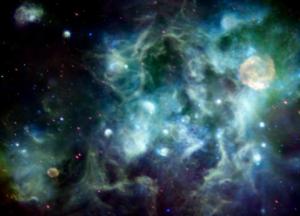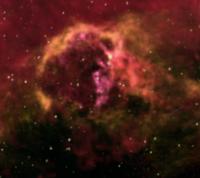 Jayanne English's Homepage
Jayanne English's Homepage
The following links indicate what images I've constructed or participated in
constructing. The information is usually on another institute's website,
so use your "back" button to return here. Copyright information is
often attached to the image, but if not please
contact me.
 |
National Radio Astronomy Observatory Image Contest - First Prize 2006 A Majestic Gas Shell Revealed by the VLA. -- This image, created by myself and Jeroen Stil with the support of Russ Taylor (U Calgary), shows cold hydrogen gas shell, GS 62.1+0.2-18, residing in the plane of our Milky Way Galaxy. One of the telescopes it uses is the VLA, the radio telescope array used in the movie Contact. Our eyes do not detect radiation so this gas is "invisible" but very important to the formation of stars, planets and even life itself. |
|
 The Canadian
Galactic Plane Survey (CGPS) Image Gallery | These images use the Dominion Radio Astrophysical Observatory.-- An array of radio antennas in Penticton, British Columbia. Our eyes do not detect radiation from the radio spectrum but we wouldn't want to ignore these data. Radio telescopes capture the emission from the material between stars: cold gas, fast moving particles (called Cosmic Rays), and magnetic fields. This allows us to study star formation, star death, the structure of galaxies and the motions of galaxies and the material within them. The CGPS is now part of the International Galactic Plane Survey; both surveys study our home galaxy, the Milky Way Galaxy. Most of the current colour images at the CGPS Image Gallery have been put together by me with support by Russ Taylor (University of Calgary). These CGPS images are copyrighted. If your intended use is not strictly personal or for astronomy education purposes, but for commercial purposes, please contact me. Click on image for a animation from CGPS, IRAS, and CO data of an expanding shell, in the DRAO Deep Field, called GSH138-01-094. 
| The Hubble Space Telescope Gallery
and Public Information | The radiation detected from the Hubble Space Telescope (HST) not only includes light that our eyes would see, but also radiation from the infra-red and and ultra-violet which we do not see. (The links below explain Constructing Colour Astronomy Images). The HST images capture light from stars and hot (ionized) gas. My newest HST image are made in collaboration with my science colleagues particularly Sarah Gallagher at University of Western Ontario and Jane Charlton at Penn State.
|

| In 1998-2000 I coordinated the Hubble Heritage Team of image-makers at the Space Telescope Science Institute. This group works collaboratively to decide on the final form of an image. However there is a lead image-maker who does the experimenting and presents options to the team. I was lead image-maker for
These HST images are public domain though their intended use is for personal or for astronomy education purposes.
|
 Combining Public Images | Colour Images can also be combined to give a fresh perspective. This one combines the HST's Heart of the Crab Nebula, with the Chandra X-ray Observatory image, and David Malin's image of the Crab Nebula and its surrounding region. These images are copyrighted. If your intended use is not strictly personal or for astronomy education purposes, but for commercial purposes, please contact me and photo@aaoepp.aao.gov.au to acquire permission for use. |